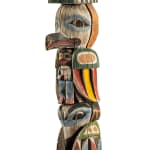-
Artworks
PROBABLY SAM WILLIAMS (c. 1884-1979) NUU-CHAH-NULTH
Model Totem Pole, c. 1920swood and paint, 26.75 x 4.5 x 3.25 in (67.9 x 11.4 x 8.3 cm)
unsigned
LOT 104
ESTIMATE: $1,800 — $2,000
PRICE REALIZED: $3,840.00Further images
The sculptural style and paint color choices illustrated here are those of an early twentieth-century family of carvers from the Nitinaht area of southwestern Vancouver Island. Known as Sam Williams...The sculptural style and paint color choices illustrated here are those of an early twentieth-century family of carvers from the Nitinaht area of southwestern Vancouver Island. Known as Sam Williams (c. 1884-1979) and his son Wilson Williams (c. 1908-1965), the two men carved souvenir totem poles for sale to local curio shops and to dealers in Seattle between about 1910 and 1950, and their descendants have continued the tradition to the present. Like many other southern-coast artists of their day, their culture rarely carved tall totem poles in the historic period, and they were likely disinclined to replicate poles from their own area that had been raised ceremonially. Instead they turned to working loosely with photographs of totem poles from the northern part of the NW Coast, where totem poles were ubiquitous. Totem poles of SE Alaska were common subjects for photographic post cards sold in that period, particularly two well-known poles from Wrangell village, of which this is a carving of the one commonly called the Raven Pole, erected by a descendant of Chief Shakes in that village. A full-size forty-foot reproduction of that pole carved in 1986 stands today in Kiks’adi Park, a thumbnail totem park in downtown Wrangell with replicas of three more historical poles present.
The same figures, in vastly different carving styles, appear on the original Raven pole and this model of the same monument. From the top, they are Raven as Clan Leader/Shaman, standing on the box or chest that once held the Light; the sun, moon, and stars. Below that, illustrating another of the Raven cycle stories, is Raven’s grandfather, who kept the box with the Light in his house. Between his wings is the old Raven’s daughter, who gave birth to Raven the young boy who stole the Light and released it to the World.
The image below them was originally a composite figure made up of two entities: an older Raven and a younger one, facing each other and joined at the tongue, exchanging cultural information. The smaller figure was most likely eliminated here due to the small scale of the carving. The bottom figure represents an important historical traveler, one who led the people in stories of survival against hardships. The rod in his hands is a kind of magic directional stick, which could predict the best route to go to solve a given situation. The original Raven pole was erected in the winter of 1896, and photographed by Winter and Pond of Juneau shortly after. They produced postal cards with pictures of this and other nineteenth-century SE Alaska poles that became very popular.
Steven C. Brown
References: For an interesting discussion of the Williams family of carvers and their dealings with Seattle curio shops see “Inside the Northwest Coast Curio Trade: Ye Olde Curiosity Shop and the Williams Family” in Michael D. Hall and Pat Glascock, Carvings and Commerce: Model Totem Poles 1880-2010 (Saskatoon: Mendel Art Gallery / Seattle: University of Washington Press, 2011), pp. 22-29; a 1940s pole by Sam Williams is illustrated on page 135.
Join our mailing list
* denotes required fields
We will process the personal data you have supplied in accordance with our privacy policy (available on request). You can unsubscribe or change your preferences at any time by clicking the link in our emails.










